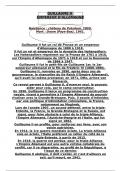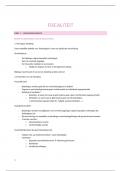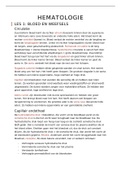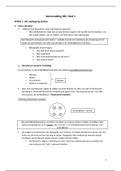A-Level Chemistry
Topic 2
Bonding and Structure
Name: ___________________________
Form: ___________
Teacher:________________________
1
, Topic 2: Bonding and Structure - Specification
PART 1: FUNDAMENTALS OF BONDING AND STRUCTURE
Part 1(a): Ionic Bonding
Part 1(b): Metallic Bonding
Part 1(c): Covalent Bonding
Part 1(d): Electronegativity
2
,And in General (Covering Parts 1(a),(b),(c)
PART 2: SHAPES OF MOLECULES
PART 3: INTERMOLECULAR FORCES
3
, PART 1: FUNDAMENTALS OF BONDING AND STRUCTURE
Part 1(a): Ionic Bonding
Ionic bonding is the strong electrostatic attraction between oppositely charged ions.
Formation of ions: Dot and Cross diagram revision
E.g. sodium chloride E.g. magnesium fluoride
Chemistry HELP-SHEET 12
LATTICE ENTHALPY (ENERGY)
WARNING
There are two definitions - one is the opposite of the other!
Make sure you know which one is being used.
Lattice Dissociation Enthalpy
Definition The enthalpy change when ONE MOLE of an ionic lattice dissociates into isolated gaseous ions.
Values • highly endothermic - strong electrostatic attraction between ions of opposite charge
What determines the strength of anmust
• a lot of energy ionicbebond
put in and hence the
to overcome an attraction
ionic structure?
• relative values are governed by the charge density of the ions.
The strength of an ionic bond is related to its lattice energy. The more exothermic the lattice energy, the stronger
the ionic Example
bonds. Na+ Cl¯(s) -———> Na +(g) + Cl¯(g)
Lattice Energy facts (also see Topic 8 (Born Haber cycles))
Lattice Formation Enthalpy
Definition The enthalpy change when ONE MOLE of an ionic lattice is formed from its isolated gaseous ions.
Values • highly exothermic - strong electrostatic attraction between ions of opposite charge
• a lot of energy is released as the bond is formed
• relative values are governed by the charge density of the ions.
Example Na+(g) + Cl¯(g) -———> Na + Cl¯(s)
Notes • one cannot measure this value directly ; it is CALCULATED USING A BORN-HABER CYCLE
• the greater the charge densities of the ions, the more they attract each other and the
larger the lattice enthalpy.
• the higher the lattice enthalpy, the higher the melting point of the compound
• solubility of ionic compounds is affected by the relative values of Lattice and Hydration Enthalpies
Theoretically, lattice energy is proportional to
Some Lattice Enthalpy Values
Cl¯ Br¯ F¯ O2-
Check which definition Na+ -780 -742 -918 -2478
is being used and use K+ -711 -679 -817 -2232
appropriate sign for DH Rb+ -685 -656 -783
Mg2+ -2256 -3791
Ca2+ -2259
4
Smaller ions will have a greater attraction for each other because of their higher charge density. They will
have larger Lattice Enthalpies and larger melting points because of the extra energy which must be put in to
separate the oppositely charged ions.
Topic 2
Bonding and Structure
Name: ___________________________
Form: ___________
Teacher:________________________
1
, Topic 2: Bonding and Structure - Specification
PART 1: FUNDAMENTALS OF BONDING AND STRUCTURE
Part 1(a): Ionic Bonding
Part 1(b): Metallic Bonding
Part 1(c): Covalent Bonding
Part 1(d): Electronegativity
2
,And in General (Covering Parts 1(a),(b),(c)
PART 2: SHAPES OF MOLECULES
PART 3: INTERMOLECULAR FORCES
3
, PART 1: FUNDAMENTALS OF BONDING AND STRUCTURE
Part 1(a): Ionic Bonding
Ionic bonding is the strong electrostatic attraction between oppositely charged ions.
Formation of ions: Dot and Cross diagram revision
E.g. sodium chloride E.g. magnesium fluoride
Chemistry HELP-SHEET 12
LATTICE ENTHALPY (ENERGY)
WARNING
There are two definitions - one is the opposite of the other!
Make sure you know which one is being used.
Lattice Dissociation Enthalpy
Definition The enthalpy change when ONE MOLE of an ionic lattice dissociates into isolated gaseous ions.
Values • highly endothermic - strong electrostatic attraction between ions of opposite charge
What determines the strength of anmust
• a lot of energy ionicbebond
put in and hence the
to overcome an attraction
ionic structure?
• relative values are governed by the charge density of the ions.
The strength of an ionic bond is related to its lattice energy. The more exothermic the lattice energy, the stronger
the ionic Example
bonds. Na+ Cl¯(s) -———> Na +(g) + Cl¯(g)
Lattice Energy facts (also see Topic 8 (Born Haber cycles))
Lattice Formation Enthalpy
Definition The enthalpy change when ONE MOLE of an ionic lattice is formed from its isolated gaseous ions.
Values • highly exothermic - strong electrostatic attraction between ions of opposite charge
• a lot of energy is released as the bond is formed
• relative values are governed by the charge density of the ions.
Example Na+(g) + Cl¯(g) -———> Na + Cl¯(s)
Notes • one cannot measure this value directly ; it is CALCULATED USING A BORN-HABER CYCLE
• the greater the charge densities of the ions, the more they attract each other and the
larger the lattice enthalpy.
• the higher the lattice enthalpy, the higher the melting point of the compound
• solubility of ionic compounds is affected by the relative values of Lattice and Hydration Enthalpies
Theoretically, lattice energy is proportional to
Some Lattice Enthalpy Values
Cl¯ Br¯ F¯ O2-
Check which definition Na+ -780 -742 -918 -2478
is being used and use K+ -711 -679 -817 -2232
appropriate sign for DH Rb+ -685 -656 -783
Mg2+ -2256 -3791
Ca2+ -2259
4
Smaller ions will have a greater attraction for each other because of their higher charge density. They will
have larger Lattice Enthalpies and larger melting points because of the extra energy which must be put in to
separate the oppositely charged ions.











